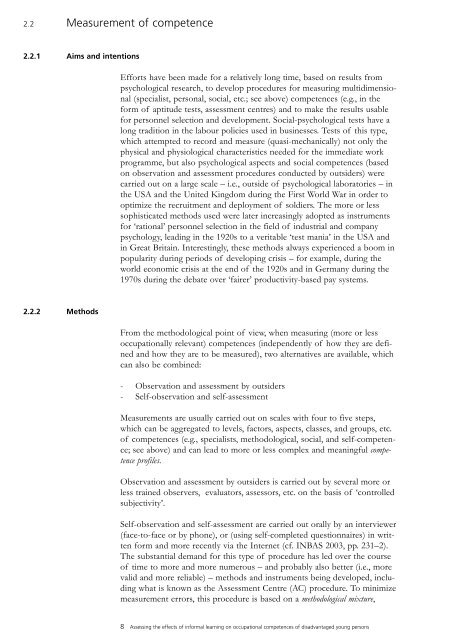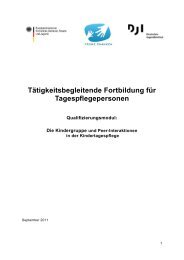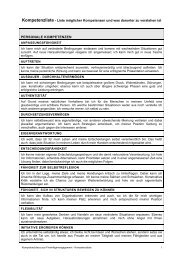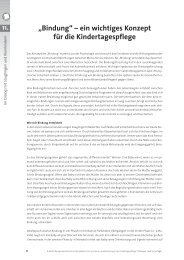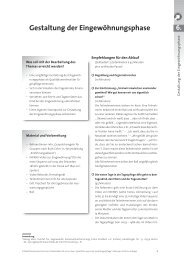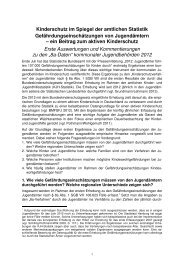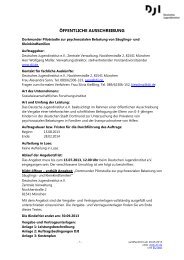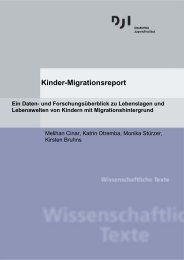Assessing the effects of informal learning on occupational compe ...
Assessing the effects of informal learning on occupational compe ...
Assessing the effects of informal learning on occupational compe ...
Create successful ePaper yourself
Turn your PDF publications into a flip-book with our unique Google optimized e-Paper software.
2.2 Measurement <str<strong>on</strong>g>of</str<strong>on</strong>g> <strong>compe</strong>tence<br />
2.2.1 Aims and intenti<strong>on</strong>s<br />
2.2.2 Methods<br />
Efforts have been made for a relatively l<strong>on</strong>g time, based <strong>on</strong> results from<br />
psychological research, to develop procedures for measuring multidimensi<strong>on</strong>al<br />
(specialist, pers<strong>on</strong>al, social, etc.; see above) <strong>compe</strong>tences (e.g., in <str<strong>on</strong>g>the</str<strong>on</strong>g><br />
form <str<strong>on</strong>g>of</str<strong>on</strong>g> aptitude tests, assessment centres) and to make <str<strong>on</strong>g>the</str<strong>on</strong>g> results usable<br />
for pers<strong>on</strong>nel selecti<strong>on</strong> and development. Social-psychological tests have a<br />
l<strong>on</strong>g traditi<strong>on</strong> in <str<strong>on</strong>g>the</str<strong>on</strong>g> labour policies used in businesses. Tests <str<strong>on</strong>g>of</str<strong>on</strong>g> this type,<br />
which attempted to record and measure (quasi-mechanically) not <strong>on</strong>ly <str<strong>on</strong>g>the</str<strong>on</strong>g><br />
physical and physiological characteristics needed for <str<strong>on</strong>g>the</str<strong>on</strong>g> immediate work<br />
programme, but also psychological aspects and social <strong>compe</strong>tences (based<br />
<strong>on</strong> observati<strong>on</strong> and assessment procedures c<strong>on</strong>ducted by outsiders) were<br />
carried out <strong>on</strong> a large scale – i.e., outside <str<strong>on</strong>g>of</str<strong>on</strong>g> psychological laboratories – in<br />
<str<strong>on</strong>g>the</str<strong>on</strong>g> USA and <str<strong>on</strong>g>the</str<strong>on</strong>g> United Kingdom during <str<strong>on</strong>g>the</str<strong>on</strong>g> First World War in order to<br />
optimize <str<strong>on</strong>g>the</str<strong>on</strong>g> recruitment and deployment <str<strong>on</strong>g>of</str<strong>on</strong>g> soldiers. The more or less<br />
sophisticated methods used were later increasingly adopted as instruments<br />
for ‘rati<strong>on</strong>al’ pers<strong>on</strong>nel selecti<strong>on</strong> in <str<strong>on</strong>g>the</str<strong>on</strong>g> field <str<strong>on</strong>g>of</str<strong>on</strong>g> industrial and company<br />
psychology, leading in <str<strong>on</strong>g>the</str<strong>on</strong>g> 1920s to a veritable ‘test mania’ in <str<strong>on</strong>g>the</str<strong>on</strong>g> USA and<br />
in Great Britain. Interestingly, <str<strong>on</strong>g>the</str<strong>on</strong>g>se methods always experienced a boom in<br />
popularity during periods <str<strong>on</strong>g>of</str<strong>on</strong>g> developing crisis – for example, during <str<strong>on</strong>g>the</str<strong>on</strong>g><br />
world ec<strong>on</strong>omic crisis at <str<strong>on</strong>g>the</str<strong>on</strong>g> end <str<strong>on</strong>g>of</str<strong>on</strong>g> <str<strong>on</strong>g>the</str<strong>on</strong>g> 1920s and in Germany during <str<strong>on</strong>g>the</str<strong>on</strong>g><br />
1970s during <str<strong>on</strong>g>the</str<strong>on</strong>g> debate over ‘fairer’ productivity-based pay systems.<br />
From <str<strong>on</strong>g>the</str<strong>on</strong>g> methodological point <str<strong>on</strong>g>of</str<strong>on</strong>g> view, when measuring (more or less<br />
occupati<strong>on</strong>ally relevant) <strong>compe</strong>tences (independently <str<strong>on</strong>g>of</str<strong>on</strong>g> how <str<strong>on</strong>g>the</str<strong>on</strong>g>y are defined<br />
and how <str<strong>on</strong>g>the</str<strong>on</strong>g>y are to be measured), two alternatives are available, which<br />
can also be combined:<br />
- Observati<strong>on</strong> and assessment by outsiders<br />
- Self-observati<strong>on</strong> and self-assessment<br />
Measurements are usually carried out <strong>on</strong> scales with four to five steps,<br />
which can be aggregated to levels, factors, aspects, classes, and groups, etc.<br />
<str<strong>on</strong>g>of</str<strong>on</strong>g> <strong>compe</strong>tences (e.g., specialists, methodological, social, and self-<strong>compe</strong>tence;<br />
see above) and can lead to more or less complex and meaningful <strong>compe</strong>tence<br />
pr<str<strong>on</strong>g>of</str<strong>on</strong>g>iles.<br />
Observati<strong>on</strong> and assessment by outsiders is carried out by several more or<br />
less trained observers, evaluators, assessors, etc. <strong>on</strong> <str<strong>on</strong>g>the</str<strong>on</strong>g> basis <str<strong>on</strong>g>of</str<strong>on</strong>g> ‘c<strong>on</strong>trolled<br />
subjectivity’.<br />
Self-observati<strong>on</strong> and self-assessment are carried out orally by an interviewer<br />
(face-to-face or by ph<strong>on</strong>e), or (using self-completed questi<strong>on</strong>naires) in written<br />
form and more recently via <str<strong>on</strong>g>the</str<strong>on</strong>g> Internet (cf. INBAS 2003, pp. 231–2).<br />
The substantial demand for this type <str<strong>on</strong>g>of</str<strong>on</strong>g> procedure has led over <str<strong>on</strong>g>the</str<strong>on</strong>g> course<br />
<str<strong>on</strong>g>of</str<strong>on</strong>g> time to more and more numerous – and probably also better (i.e., more<br />
valid and more reliable) – methods and instruments being developed, including<br />
what is known as <str<strong>on</strong>g>the</str<strong>on</strong>g> Assessment Centre (AC) procedure. To minimize<br />
measurement errors, this procedure is based <strong>on</strong> a methodological mixture,<br />
8 <str<strong>on</strong>g>Assessing</str<strong>on</strong>g> <str<strong>on</strong>g>the</str<strong>on</strong>g> <str<strong>on</strong>g>effects</str<strong>on</strong>g> <str<strong>on</strong>g>of</str<strong>on</strong>g> <str<strong>on</strong>g>informal</str<strong>on</strong>g> <str<strong>on</strong>g>learning</str<strong>on</strong>g> <strong>on</strong> occupati<strong>on</strong>al <strong>compe</strong>tences <str<strong>on</strong>g>of</str<strong>on</strong>g> disadvantaged young pers<strong>on</strong>s


